All the Answers
Well-known member
A family already spends more than $75,000 per month on electricity, gas, transportation and water: on average, rates jumped almost 160% - Infobae

Source:
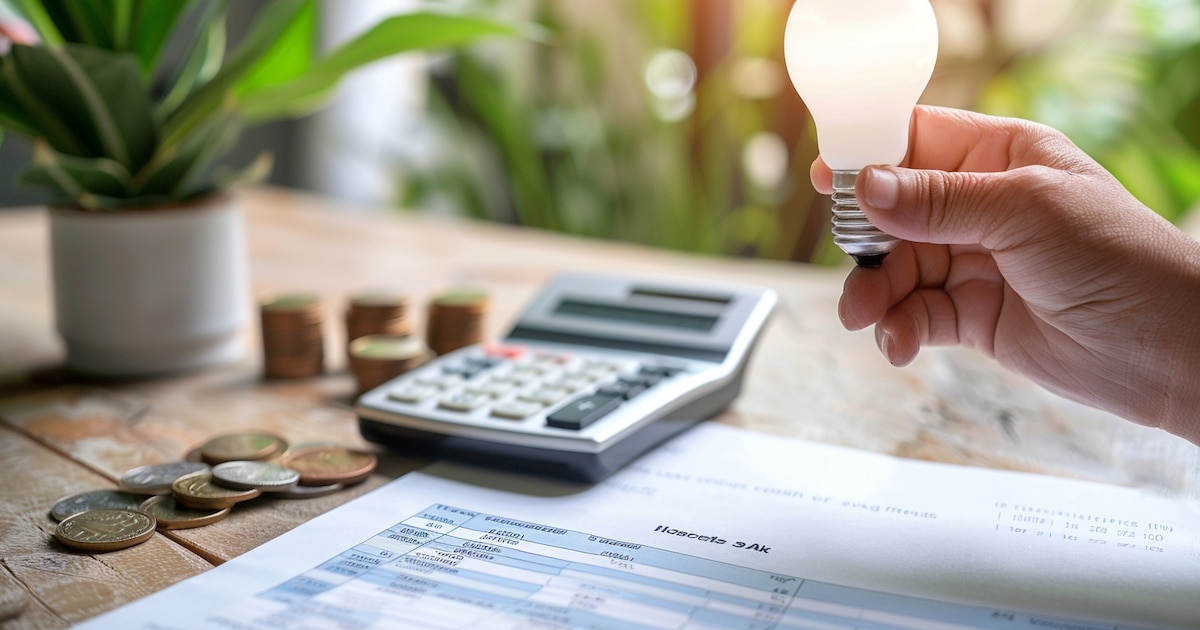
Una familia ya gasta más de $75.000 por mes en luz, gas, transporte y agua: en promedio, las tarifas saltaron casi 160%
Son datos para el AMBA del Observatorio de Tarifas y Subsidios IIEP, que hace la UBA-Conicet. La provincias donde más se paga y las que abonan menos
March 22, 2024
These are data for the AMBA from the IIEP Rates and Subsidies Observatory, which is produced by the UBA-Conicet. The provinces where they pay the most and those that pay the least
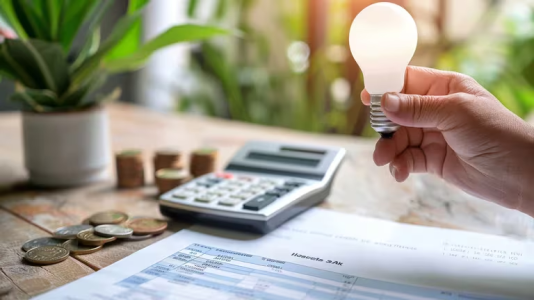
"In the month of March, an average household in the AMBA spends $75,429 in the month to cover their energy, transportation and drinking water needs at home," the report detailed (Illustrative Image Infobae)
The basket of public services does not stop rising, amid increases in rates and removal of subsidies.
Although a good part of the path of increases and cuts that Javier Milei 's government intended to implement was somewhat relegated for the moment, with the idea that the inflation variable - central to the official strategy - does not end up getting out of control, in the last three months recorded a jump in the aforementioned basket of 156 percent.
“The basket of public services of the AMBA includes the consumption of electricity, natural gas, drinking water and public transportation. In this sense, it reflects the average cost of public services for a representative household in the AMBA. In the month of March, an average AMBA household spends $75,429 in the month to cover its energy, transportation and drinking water needs at home,” detailed the report from the IIEP Rates and Subsidies Observatory, carried out by UBA-Conicet.
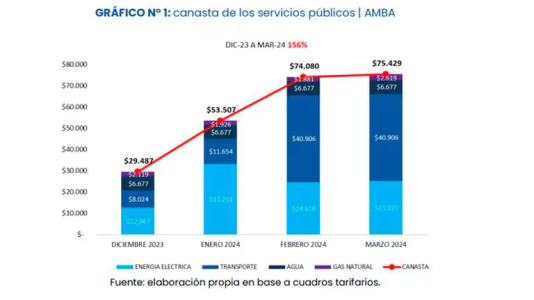
Rates between December and March
“The cost of the total basket increased 156% compared to December 2023 from the updates to transportation and electricity rates since the water and natural gas rate tables have not been modified so far. At the same time, in natural gas and electric energy, consumption is adjusted for seasonality,” the report stated.
When each service was analyzed in detail, the work showed that the most important increase was for transportation with an increase of 410% compared to December 2023, while electric energy increased 99% and gas 24%. In the latter case, as there are no increases in the tariff schedule, it corresponds exclusively to the monthly differences in the quantities consumed.
“With these values, in March, the AMBA basket of public services occupies 11% of the average salary registered for the month while the most important weight within the services is occupied by transportation spending,” explained the Observatory.
Regarding subsidies, it was noted that, accumulated as of March 20, real subsidies fell 69.9% year-on-year with this scheme:
- Real reduction in transportation of 50% year-on-year
- Real reduction in energy of 75.3% year-on-year
- Transfers for water subsidies were zero.
- Transportation subsidies grew 84.5% year-on-year in nominal terms and decreased 50% year-on-year in real terms.
- Transfers to Aerolíneas Argentinas were null.
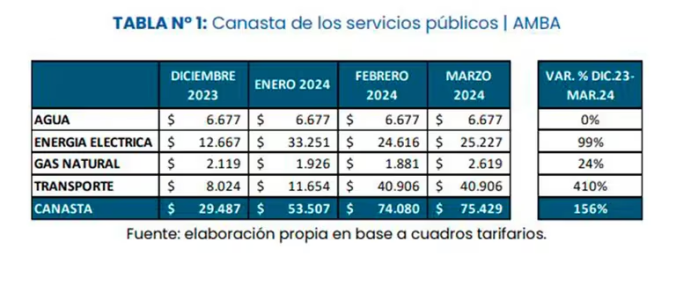
How much do you pay for each service
“Energy subsidies, which represent 62% of total subsidies and decrease 6.6% nominal year-on-year while reducing 75.3% real year-on-year. However, it is necessary to clarify that as of the twentieth of March, no transfers accrued to Cammesa during the current month have been recorded,” the report stated.
In values, as of March 2024, subsidies accumulate $10.4 trillion in the last twelve months, a real drop of 25% compared to the same previous period (accumulated between April 2022 and March 2023) and 43% compared to the peak observed in June 2022. “When analyzing the accumulated twelve-month data, it is relevant that the subsidies allocated to Cammesa in the month of July 2022 were $0 which, unlike the months of January and February, is an unlikely situation given The context: the seasonality of the winter consumption peak and the transfers made in the previous and subsequent month. At the same time, once again, at the end of the report, Cammesa did not accrue transfers in the month of March.”
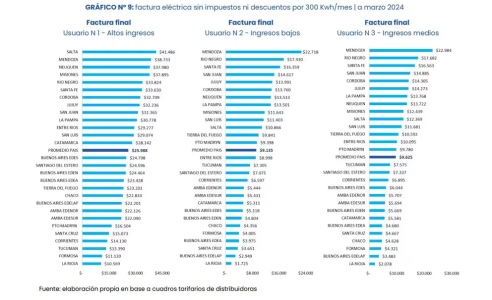
Average electricity expenditure in each province in March
For the AMBA, the average bills for electricity and natural gas are lower in real terms than those observed in February 2019. In the case of gas, this reduction continues due to the temporary suspension of the scheduled increases.
- “For users of Level 2 (low income) and level 3 (medium income), the average final bill had a recomposition in February due mainly to the increase in the fixed and variable charge as a result of the recomposition of the Own Distribution Cost.”
- “For a consumption of 300 kwh/month, the final bill with taxes was reduced in real terms due to the latest inflation data for the month of February and its estimate for March because in the last month the rate tables had no changes. For this reason, the recomposition of the month of February in the distribution charge, and for the N 1 additionally in the price of energy, was considerably reduced.”
- “On the other hand, the new rate tables for the AMBA, effective as of February, would face an inflation of 28% in the February-March two-month period. For this reason, the bill recomposition of 164%, 119% and 108% for households N1, N2, and N3 would be transformed into a real recomposition of 106%, 71% and 63% respectively at the end of the month of March.”
- The average gas bill shows a somewhat different dynamic. Between February 2019 and February 2023, the start month of subsidy segmentation, the residential rate for average natural gas consumption was reduced in real terms. From then on, and until March 2024, there was an additional real reduction for all levels with a greater magnitude observed in N 1. In turn, at the time of presenting this report, the decision on the price of gas and the tables tariffs are suspended.
- "Finally, in March the average gas bill for Level 1, Level 2 and Level 3 users fell in real terms by 64%, 82% and 79% compared to the pre-segmentation bill respectively."
How much is paid for services in the provinces
The framework report that Resolution 7/24 of the Ministry of Energy has been in force since March, which sets the seasonal prices of electrical energy for the period February-April 2024 throughout the national territory: “A transversal analysis indicates that the bill “The average final bill of a high-income household is 2.8 and 2.7 times higher than the bill of a household N 2 and N 3 respectively.”Thus, the total average electricity bill for the entire country (without taxes or discounts for 300 Kwh/month) is $25,988 for a high-income household (N1), $9,135 for a middle-income household (N3) and $9,625 for a household low income (N2).
- For the first group, the highest average is paid by Salta, with 41,486 pesos and the lowest by La Rioja, with 10,596 pesos.
- In the middle income group, Mendoza stands out, with an average monthly expense of $22,984. La Rioja closes with $2,078.
- The low-income list is headed by Mendoza, with an average monthly expense of $22,718. At the other end, La Rioja is also located with $1,725.

